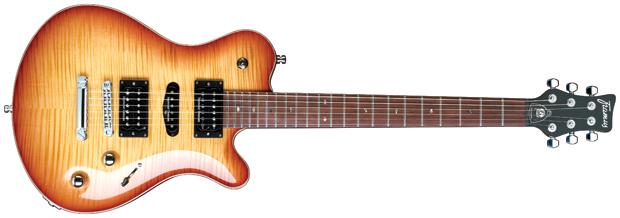Review: Framus Panthera Studio Supreme

Many guitarists argue with fanatical intensity over whether a modern instrument can create magical tones on par with those of prized vintage guitars.
This debate is especially hot and polarizing when the discussion is focused on mahogany, single-cut guitars. Framus’ Panthera Series guitars put this argument to rest, proving that phenomenal, benchmark tones can be achieved not only as a byproduct of age and circumstance but also through application of repeatable techniques. Poised at the top of the tonal altar is Framus’ flagship, the Panthera Studio Supreme. Its combination of exotic hardwoods and specially selected components makes it capable of producing sustain and tone that seem almost supernatural.
FEATURES
Part of this magic is down to Framus’ choice and handling of wood. The company’s open-air curing process exposes the woods to years of temperature variance and Bavarian mountain breezes. Beyond this, Framus carefully manages and monitors the water density in each piece of wood that will potentially become part of an instrument.
The guitar’s Sixties-style, C-shaped neck is made of highly figured, West African Ovangkol instead of the more common mahogany. Although Ovangkol is similar in many ways to rosewood, it has a superior midrange bloom, detailed note production and copious even-order harmonics. With the Ovangkol mated to the Framus’ maple-capped mahogany body, the synergy of tonal characteristics creates a choir of singing, angelic sound. Many players consider this to be the holy trinity of tonewood blends.
No expense was spared in the Panthera Studio Supreme’s details. Fit and finish are dead perfect, the electronics cavities are covered in mahogany panels that match the body’s grain, and real abalone shell is used for the oval fretboard inlays and headstock logo. With the exception of the highly polished, AAA flamed-maple top, all of the Panthera’s woods are naturally finished in oil, allowing the instrument to breathe. The quality is matched by the impressive hardware, which includes a locking TonePros bridge, Sperzel Trim-Lok machines and a low-friction Black Tusq Graph Tech nut. The solid nature of these components helps keep vibrations focused within the wood.
Framus chose Seymour Duncan Alnico II Pro pickups for the neck and middle positions and placed an SH-5 Custom in the bridge. A standard five-way blade switch lets you select pickups, and a push/pull tone pot splits the humbuckers’ coils. A toggle on the upper bout engages Framus’ Lead Free circuit, which activates and routes the bridge humbucker’s output directly to the jack, no matter which pickup is selected, bypassing all other circuitry and pots for a stellar, wide-open sound.
Get The Pick Newsletter
All the latest guitar news, interviews, lessons, reviews, deals and more, direct to your inbox!
PERFORMANCE
The Panthera Studio Supreme is one of the top-five best-sounding guitars that I’ve had the pleasure to play. It’s so rare to have this much midrange clarity coupled to glowing low-end warmth and chirping attack. The superlative sounds aren’t immediately apparent acoustically, but the subtle details spring to life once amplified.
Played through amps that ranged from a Mesa Mark Five to a Hughes & Kettner TubeMeister and a Fender Super-Sonic, the Panthera Studio Supreme consistently surprised me with its rich variety of overtones, stunning balance and responsiveness. It’s one of those guitars that connects to the player and just seems to do exactly what you want.
Activating the Lead Free switch sends all of that sound into overdrive, opening the top end, creating more power and increasing depth. I must say, though, that the most impressive qualities are the tone and length of sustain. Bend any note and the Framus almost immediately responds with practically endless, on-pitch harmonic feedback. It’s something that I’ve only ever heard from one late-Fifties single-cut, valued in the six-figure range.
“It holds its own purely as a playable guitar. It’s really cool for the traveling musician – you can bring it on a flight and it fits beneath the seat”: Why Steve Stevens put his name to a foldable guitar
“Finely tuned instruments with effortless playability and one of the best vibratos there is”: PRS Standard 24 Satin and S2 Standard 24 Satin review









